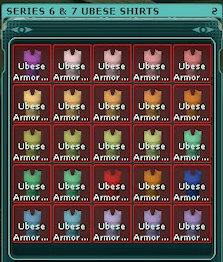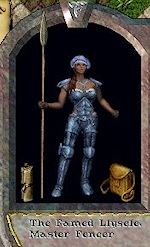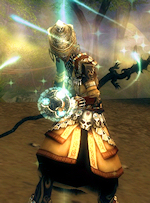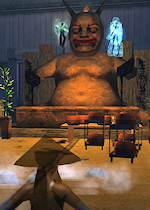 Anyone who knows me knows I love sandboxes. There’s something about an interactive simulation that’s a lot more engaging and replayable than yet another scripted themepark. And one of the best aspects of the best sandboxes is a strong player economy. The economy game is basically PvP for smart people. No — observant people. It’s as much about anticipation and reaction as combat PvP, but it’s not instant — it’s thoughtful. Eventually, it becomes instinctive, but it’s never twitch. It’s based on your personal skills as a player, not your connection, and not your gear.
Anyone who knows me knows I love sandboxes. There’s something about an interactive simulation that’s a lot more engaging and replayable than yet another scripted themepark. And one of the best aspects of the best sandboxes is a strong player economy. The economy game is basically PvP for smart people. No — observant people. It’s as much about anticipation and reaction as combat PvP, but it’s not instant — it’s thoughtful. Eventually, it becomes instinctive, but it’s never twitch. It’s based on your personal skills as a player, not your connection, and not your gear.
But there’s never been a perfect MMO economy, not even the one monitored and meddled in by a professional economist. Inflation… inflation is the enemy. At some point in time, perhaps half a year or more into the lifetime of the game, the amount of money flowing into the game via quest rewards and monster drops far exceeds the amount of money being drained out of the economy. In other words, there aren’t enough gold sinks for the gold coming from the gold faucet. Slowly but surely, money becomes worth less and less, and the more player-driven the economy, the worse the situation for players new to the sandbox, because the amount of money they can squeeze from the faucets pales in comparison to the huge stocks of “old money” being traded between wealthy players.
And while that might be fair and necessary for real life, it’s terrible game design — at least, if you care about player retention. I’d like to talk about a few games and how they approach (or fail to approach, to their own doom) this problem.
Star Wars Galaxies
 Inflation has struck the worlds of SWG upside the face with a two-by-four, and SOE has utterly failed to prevent or even attempt to slow it down. Initially, the gold sinks imposed upon players were sufficient to keep the pace of inflation very slow, especially during the first two years of the game. Player cities were extremely expensive to maintain in that early era; mission payouts were very low; and costs of housing, skill training, harvester maintenance, and death kept players cycling money out of the game. A balance of item decay, limited resources, and expensive crafting ensured the money already in the economy changed hands frequently.
Inflation has struck the worlds of SWG upside the face with a two-by-four, and SOE has utterly failed to prevent or even attempt to slow it down. Initially, the gold sinks imposed upon players were sufficient to keep the pace of inflation very slow, especially during the first two years of the game. Player cities were extremely expensive to maintain in that early era; mission payouts were very low; and costs of housing, skill training, harvester maintenance, and death kept players cycling money out of the game. A balance of item decay, limited resources, and expensive crafting ensured the money already in the economy changed hands frequently.
Unfortunately, years and years of increasing mission payouts and the addition of lootable items that are salable to junk dealer NPCs for cash (while players are AFK, no less) have created vast sums of credits that are not being drained out of the game. The gold sinks have remained constant and are now trivial, such that even a poor player can maintain an entire metropolis alone. The Starsider server is particularly stricken as a result of free character transfers that saw (according to some estimates) 40% of the total SWG playerbase take up residence there, bringing their piles of cash along with them. Worse, parts of the economy suffer stagflation as certain industries have too many participants and not enough demand, keeping the prices of some goods — even consumable goods — even with the prices of 2004 (food crafting is one such industry) in spite of the fact that players have billions more credits to spend. The triviality of money ensures that players are not incentivized to change careers in the pursuit of credits; crafters “craft to craft” as hobbyists, not for profit. Ironically, this is the only thing that allows newcomers to the sandbox to participate — player-made goods like armor, weapons, and consumables are artificially cheap and affordable, which would not normally be true in a merely inflated economy.
As much as I adore SWG, SOE has created a worst-case scenario MMO economy and seems deaf to pleas to fix it. Easy suggestions to drain money from the economy: allow players to purchase TCG cards with credits from SOE; increase the cost of housing, maintenance, and player cities by significant amounts (I’d start at a billion a year for a metro); and introduce additional luxuries like titles, badges, houses, ships, and so forth, purchaseable from SOE for exorbitant prices.
Ultima Online
 Ultima Online is another riches-to-rags game design example. It began in 1997 as a strong hybrid economy. Monsters dropped both gold coins and loot; NPCs purchased many items from players, and yet they also sold critical items to players, expensive items like magical reagents and housing deeds. Because the early game was driven by PvP and player looting, most players gravitated toward using items they could afford to lose, i.e., player-crafted goods like armor, weapons, potions, scrolls, and so forth. Much like SWG, UO had enough sinks to ensure inflation was slow indeed, and gameplay ensured that crafters were forever in demand.
Ultima Online is another riches-to-rags game design example. It began in 1997 as a strong hybrid economy. Monsters dropped both gold coins and loot; NPCs purchased many items from players, and yet they also sold critical items to players, expensive items like magical reagents and housing deeds. Because the early game was driven by PvP and player looting, most players gravitated toward using items they could afford to lose, i.e., player-crafted goods like armor, weapons, potions, scrolls, and so forth. Much like SWG, UO had enough sinks to ensure inflation was slow indeed, and gameplay ensured that crafters were forever in demand.
If you thought I was going to blame the economic downfall of UO on Trammel (the non-PvP facet of the game), you’re wholly mistaken. In fact, it was the Age of Shadows expansion in 2003 that shook UO’s economy to its core. Known as the “diabloification” of UO, AoS transformed the game from a skill-based one to an item-based one. It added armor that made magical reagents unnecessary (taking out a major gold sink); it added named, mob-dropped artifacts that rendered most crafted items obsolete; and it added insurance and repair systems that ensured players would never lose or need new gear. Instead of sending money and resources out of the economy through the original sinks, players began hoarding their money and trading it only to each other in ever-larger sums for the rare artifacts that made them powerful enough to take on monsters they were never meant to fight alone, bringing still more money into the economy and creating runaway inflation. In 2009, the game introduced a new skill called Imbuing, which again tipped the balance of power toward crafters, but the damage was done. The game is nearly unapproachable for new or returning players as the amount of money they can squeeze from the faucet is paltry compared to the funds needed to buy a single piece of gear.
Sandboxes aren’t the only games that suffer economic inflation, but strangely, in my experience sandparks and themeparks weather it better. Let’s look at a few examples.
Guild Wars
 Guild Wars has suffered inflation, it’s true, but ArenaNet hasn’t ever stopped fighting it. The game is unusual in that it has remained wholly skill-based throughout its history. Power-creep is sharply curbed; acquiring a “perfect” weapon and “max” armor is roughly as cheap today as it was when the game launched in 2005 and remains impressively accessible for new or poor players. How is it achieved? Guild Wars’ unusual crafting system is a pure but consistent money sink. Players “salvage” (destroy) dropped items in return for resources or buy those resources at heavily marked-up prices through NPC brokers (a net goldsink), then players submit these resources and money to NPC crafters, who deliver the requested armor and weapons. The crafters can also fashion luxury armors for wealthy players; these elite armors do not provide any additional bonuses over those worn by poorbies, but they drain vast sums of money out of the economy (usually in the range of 50 plat to well over 1000 plat, depending on the armor). Additional sinks include skill purchases, which quickly rise to 1 plat apiece, and guild halls, which can run a new guild over 500 plat to trick out.
Guild Wars has suffered inflation, it’s true, but ArenaNet hasn’t ever stopped fighting it. The game is unusual in that it has remained wholly skill-based throughout its history. Power-creep is sharply curbed; acquiring a “perfect” weapon and “max” armor is roughly as cheap today as it was when the game launched in 2005 and remains impressively accessible for new or poor players. How is it achieved? Guild Wars’ unusual crafting system is a pure but consistent money sink. Players “salvage” (destroy) dropped items in return for resources or buy those resources at heavily marked-up prices through NPC brokers (a net goldsink), then players submit these resources and money to NPC crafters, who deliver the requested armor and weapons. The crafters can also fashion luxury armors for wealthy players; these elite armors do not provide any additional bonuses over those worn by poorbies, but they drain vast sums of money out of the economy (usually in the range of 50 plat to well over 1000 plat, depending on the armor). Additional sinks include skill purchases, which quickly rise to 1 plat apiece, and guild halls, which can run a new guild over 500 plat to trick out.
At one point, legitimate and illegitimate farming for money to pay for these elite cosmetic armors was so extreme that ArenaNet decided the only course of action was to reduce the amount of gold entering the game, cutting it back to up to 1/8th of the previous gold flow for solo players. Players were furious, probably rightly so, as it hurt newbies in the short-term and did little to dent the vast gold resources of the already-rich. Years later, inflation still afflicts Guild Wars, but it is primarily seen in the market for the very highest-end weapon skins, minipets, and armor resources like ectos and rubies (in fact, many players use the valuable ectos and rubies as currency as a result of the account money-caps, driving up the price of those rarest resources). This has been exacerbated artificially in some respects due to the Hall of Monuments system, which aims to reward future Guild Wars 2 players based on their Guild Wars accomplishments by counting such things as the number of minipets they secure and the number of elite armor sets and weapons they acquire. There is very little demand for regular items, and the lack of an adequate mechanism for trade certainly hinders everyone, but for the most part, newcomers are not crippled in their pursuit of top-stat items and can compete in PvP as soon as they purchase or unlock sufficient skills.
City of Heroes
 Paragon Studios has been tweaking the City’s economy for years, taking a drastic move in 2010 to merge the auction houses across all factions and servers. Consequently, all of the players participate in one giant shared economy, even though they’re split physically on different shards. City of Heroes eschews many MMO tropes and therefore avoids some of the common problems. Costumes (including weapons) and buffs are relatively cheap and do not affect a character’s power. Powers themselves are earned freely as the character levels. Customization comes in the form of enhancements (SOs), which were originally dropped from enemies and purchased from NPCs, the latter of which provided a large gold sink for the game, as did expenses associated with supergroups and costume resets.
Paragon Studios has been tweaking the City’s economy for years, taking a drastic move in 2010 to merge the auction houses across all factions and servers. Consequently, all of the players participate in one giant shared economy, even though they’re split physically on different shards. City of Heroes eschews many MMO tropes and therefore avoids some of the common problems. Costumes (including weapons) and buffs are relatively cheap and do not affect a character’s power. Powers themselves are earned freely as the character levels. Customization comes in the form of enhancements (SOs), which were originally dropped from enemies and purchased from NPCs, the latter of which provided a large gold sink for the game, as did expenses associated with supergroups and costume resets.
But as the game aged, Paragon decided to inject more depth into the game with a new crafting system, one that created an entirely new tier of enhancements (IOs) crafted by players with materials and recipes gathered as drops, through trade, via missions, and from NPCs. More money was funneled into the game than taken out as a result of this system, and old gold sinks like SOs were neutered as players stopped purchasing them in favor of the new crafted IOs. After a few years (and a dozen farming exploits), inflation plagued the game, sending the auction hall prices for some rare recipes into the billions of Inf. Because SOs and non-set IOs still exist and are adequate for even high-end play, newcomers to the game are not crippled significantly. In fact, they can make a considerable amount of money simply by playing the game and the market, selling to the wealthy players themselves. Nevertheless, just as in Guild Wars, CoH’s highest-end markets are inflated and cannot be fixed if Paragon does not add massive new gold sinks to the endgame.
World of Warcraft
 WoW is the themeparkiest of the games I mean to consider here. Blizzard started out by heavily limiting the amount of gold coming into the economy and imposing strict money sinks, especially for mounts (anyone who played the first few months of the game can recall how relatively expensive were the level-40 mounts). But with subsequent expansions, money-creep as well as power-creep became huge problems. The Burning Crusade and Wrath of the Lich King expansions notoriously showered players in huge amounts of gold via quest rewards, and unfortunately for the economy, the additional tiers of new mounts provided scant sinks for all of that gold (even 4,000 gold in BC became an insignificant amount to drop, as did 20,000 in WotLK). Blizzard rightly shifted its sink-focus to luxuries for highbies and reduced these sinks for lowbie characters, surmising correctly that most of the money circulating in the game is generated in between expansions while characters are bored at the level-cap, something newcomers would not encounter.
WoW is the themeparkiest of the games I mean to consider here. Blizzard started out by heavily limiting the amount of gold coming into the economy and imposing strict money sinks, especially for mounts (anyone who played the first few months of the game can recall how relatively expensive were the level-40 mounts). But with subsequent expansions, money-creep as well as power-creep became huge problems. The Burning Crusade and Wrath of the Lich King expansions notoriously showered players in huge amounts of gold via quest rewards, and unfortunately for the economy, the additional tiers of new mounts provided scant sinks for all of that gold (even 4,000 gold in BC became an insignificant amount to drop, as did 20,000 in WotLK). Blizzard rightly shifted its sink-focus to luxuries for highbies and reduced these sinks for lowbie characters, surmising correctly that most of the money circulating in the game is generated in between expansions while characters are bored at the level-cap, something newcomers would not encounter.
Consequently, newbie players are generally unaffected by the economy while they’re leveling to 85 — most earn enough money to purchase their non-luxury riding abilities while simply playing through the content. However, the lack of sufficient sinks for high-end players even today drives the value of gold down and the price of the only (relatively) limited resource in the game — crafted goods and materials — ever skyward, keeping most casual players out of the market and encouraging a thriving yet illegal RMT network.
Conclusion
Like other forms of PvP, player economies are frequently neglected and left to stagnate and die at the hands of inflation, which is entirely the fault of poor game design and maintenance. The only way to combat the problem is to continuously monitor and adjust faucets and sinks as patches are implemented, games age, and players join and leave the economy. Unfortunately, high staff turnover on most of these MMOs and a lack of training in economics ensure that something so important to a game’s health is ignored and left for devs hired too late in the game’s life to fix the problem at its source without upsetting a playerbase accustomed to money-creep.
Interestingly, while sandbox and themepark and hybrid games all suffer from inflation, sandbox games — the ones in which the player economy is most critical — seem most prone to being incapacitated by age and design flaws. Themepark games seem to navigate (though not solve) the problem by creating two separate tiers of economy — an entry-level tier (primarily designed around NPC interaction) that ensures lowbies and poorbies can play the game with little contact with the second tier, the one in which inflation directly affects the prices of the items being traded between the endgame players. GW, CoH, and WoW all feature this (probably unintentional) two-tiered system; UO lacks it completely and suffers tremendously because of it. And SWG employs a two-tiered system only in the combat/themepark parts of the game; the sandbox parts (crafting, decor, TCG) that are the primary selling point of a sandbox are deeply affected by inflation, though not as crushingly as in UO.
While there’s nothing players can do to prevent or stop the seemingly inevitable decay of aging player economies, they can at least be aware which games are hardest hit and how to minimize the frustration of trying to compete in a neglected game where the inmates are running the asylum.
I feel that I must agree with you Bree, I’ve played quite a few mmo’s where the player economy was solely driven by the old wealthy players and it was hard, if not impossible for the new players to get a brake. And I really hate it how the gold sellers seam to thrive and the game staff do nothing or hardly anything to stop them.
Fascinating analysis. Bookmarked for later going through. I have to say, I’m thrilled to have a new blog to read. You can yell at Rubi later for leading way too much attention here. 🙂 Would you have an example of a game that doesn’t suffer from too much inflation, or is it an unavoidable consequence of age?
I can’t think of one. Any system designed to create money (real or MMO) is going to have inflation. And even if you take money out of the design altogether, people will just pick a commodity and turn it into the de facto currency (like GW and ecto) and *that* will inflate.
About the only thing designers can do is sit on a system (a la the economist who monitors EVE) and tweak the faucet and sinks depending on a zillion of variables (in a game, that’d even include people leaving the game — you don’t take it with you when you die IRL!). But even EVE, which is trying most loudly to combat the problem, still has inflation! I don’t want to say it’s impossible; mathematically, it should be. A small amount of inflation is even healthy, just as in RL. I definitely wouldn’t want to see more draconian GW-style measures to cut down on the faucets, though. I suspect that is more detrimental to a game’s playerbase/morale/retention than the inflation it’s trying to combat.
Ok… 3 read-throughs later, and now my head hurts… (guess I’m not cut out to be an economist.)
I can find no fault in your assessment of the situation (although again – not an economist) and I’m not sure if you were proposing a possible solution or not… Were you suggesting that implementing some sort of more severe money-sink for higher level characters is a potential solution? Essentially, keep the “printing money” process of collecting loot while indulging in pathological serial killing at the early levels going, and gradually insert more and more “sinks” as higher levels are attained so that you are bleeding the “free money” out of the system at the top, where presumably folks can afford it, while not penalizing the noobs who are just getting started…?
Yup, that’s it in a nutshell! My one caveat would be that the moneysinks don’t need to be “severe.” I mean, we’re not trying to punish people for winning or being good at the game, right? Least of all our most dedicated players. I definitely don’t want to see sinks that drive casuals out of the game (I don’t want the endgame to become a grindfest). I tend to favor voluntary luxury sinks — draining money out of the economy by letting players buy vanity upgrades, titles, vehicles, what have you. Since this post originally went up, the folks behind Ultima Online instituted a lottery system in the game by which players could buy tickets for a chance to win brand-new housing plots in the newly renovated Magincia. I read that a LOT of money (a lot of it leftover from ancient duping exploits) was thereby taken out of the game, voluntarily.
But other games — like SWG — do need more of a crackdown. Maintenance on cities and housing in SWG is so trivial that it may as well not exist, and while normally I wouldn’t object to that, it does mean that on some servers there are simply zero city slots available (because it’s so cheap to maintain one). Things like that need to become better sinks for more than just the health of the currency!
I’m clearly one of many now catching up on this great newly discovered blog! I wouldn’t normally necropost but he started it…
I’ve always thought they should rent out prime non-instanced real estate — I’m thinking apartments with banners in the heart of downtown Stormwind / Bree / Lion’s Arch / Theed / ?? — on a monthly basis with an auction to get all the richest guilds outbidding each other for temporary high-profile presence, like a combination billboard / guild hall / hotel suite. (Maybe give members an exclusive balcony to pose on so they’ll get their mount off the mailbox I’m trying to use.) Does any game do this?
It seems like inflation is inevitable when accumulated power and rewards are never lost once gained. Skills don’t fade with time, mounts don’t wear out or die and need replacing. We leave a game for months or years and come back to everything just as we left it, and money is used to separate rewards you get early from rewards you don’t get until later.
Must it be so? Could any game succeed if unplayed characters faded to some core version of themselves but lost much of the trimmings and wealth? So your possessions, perks, or even skills are rented instead of owned?
Or flatten the curve so we don’t get exponentially more rich and powerful with every hour invested? So after 6 months or 6 years of playing we’re fighting foes of similar power as when we started, for similar pay? It always seems ridiculous when the world is divided into zones where the wolves over here are so much deadlier than the wolves over there, and killing 10 of these rewards gold instead of coppers. There must be more story-based ways (like reputation grinds, gateway unlocks, dungeon keys) to progress through content in an appropriate order and advance in prestige without the baggage of levels and ever-increasing payouts.
If GW with its level cap at 20 has resisted inflation better than most, will GW2’s level cap of 80 open an inflation can of worms? Will skill-based games like The Secret World always end up with combat ratings or gear scores that act the same as levels and are equally tied to inflation? Or does it all boil down to sinks vs. faucets, as the EVE economic newsletter would indicate, and all we need is more end-game sinks and why-oh-why can’t the devs see that?
Oh how I hate to revive posts months and months old, but I have to thank you for your amazing insights Bree.
While inflation has always been something I have been aware of, I always thought of it as an inevitability and concentrated on the mechanics that allowed for the solidifying of that two tiered noob vs. veterans as the reason for “the long death of an MMO” as you would put it (I wrote a 90 page thesis on it), especially your concept of the transference of “old money”.
But, now, moving onto a PhD and in trying to find an empirically demonstrable cause of MMO demise (as well as something I can relate to RL economies), I am now looking into the economic systems of MMOs.
Couple of things.
While I see (dynamic) gold sinks similar to a progressive taxation system, an essential tool in combating economic inequality, and, in part, inflation, wouldn’t a more effective system be more akin to real world economic management i.e. monetary policy, or regulation of the money supply, for example dynamically/progressively regulating the rewards received from high value mob kills/repeatable (money driven) quests, or charging interest on certain things, i.e. storage fees, interest on stored currency, crafting etc.
Anyways, I agree with you. I don’t understand why MMORPGs with such wildly dynamic economies don’t have people with more understanding in economics regulating them (it’s completely laissez faire purely because it is the prevailing economic paradigm), especially considering they make or break games (period, there is no sometimes).
Secondly, is there any reading you would recommend for this kind of subject.
Again, thanks for your insights, it was like a “bing” moment for me (no not the search engine). 🙂 feel free to email me at chum@sent.as about stuff (in fact, i’d like to pick your brain if u do)
Ms. Massively,
Thank you for your insightful report, even if it is now 2 years old.
I came to this article through a posting on Zero Hedge about the rampant inflation in Diablo 3 and that metaphor for the real world.
There are some inaccuracies in your report however:
You state that a little inflation is benign or even desireable. This is not the case. Even at the 2% inflation that real world central banks target, you have an exponential function that will eventually crater the system.
You state that creating a game that does not contain inflation is impossible. I believe this is also not the case. The natural state of affairs in the real world is deflationary. That is, as technology improves the tools we use and as populations increase and create better economies of scale, prices should naturally drop. Unless there is an input that is in high demand by another industry, it shoudn’t cost as much to produce a light bulb today as it did in 1900. Yet it does. The reason for this is that the present system of currency, a fiat one, is not based on mythical gold, or plats, but rather on debt. And debt abhors a deflationary world where the price of collateral decreases. Governments, the largest incurrers of debt also prefer inflation as they can pay back their sovereign debt with cheaper future dollars. They also get to tax increases in income that result as a devaluation of the dollar as increased income, not allowing it to pass by as devalued disposable income and a reduction in purchasing power. It’s acutally a global Ponzi scheme, but unfortunately right now it is the only scam, I mean scheme we have.
As the fiat systems of the MMOs are not debt-dependent, it should be possible to create an economy that does not succumb to inflation.
Here are the important concepts…
Firstly, whatever is used as currency must be durable, portable, fungible etc… These qualities are not typically problems in MMOs as encumberance is not affected and one’s wealth is persistent, and every one accepts the one currency (while it is not hyperinflationary).
Money also needs to have the slowest declining marginal utility of all goods available in the World. This particular quality (which is in part a summation of its other qualities) of gold lead to its choosing as the currency of choice wherever there is a real world free market. This is an important concept. It means that we won’t use carrots as currency because their value is in being eaten, consumed or extinguished before they rot. And without this quality, some other substitute money will be found. For example, allowing an exchange of MMO money for real world currency will destroy the MMO currency as real world currency, even if it is only fiat debt, will always have a slower declining marginal utility than MMO currency.
One of the main consequences of this quality is that all other goods in the MMO world must have a declining marginal utility. Other things must rot, age, deteriorate, be consumed, require maintenance… ALL other things. Real estate, ships, armor, furniture, whatever… and there are many creative ways to do this. This will incentivize all players to hold most of their wealth in currency and creates a demand for that currency above and beyond all barter.
The other main consequence of money’s need to have the lowest declining marginal utility is that the supply of it must be the most stable supply of anything in the game. Perhaps an algorithm based on the death and birth of new characters, and average lifespan of a character, could slowly dribble extra money into a game, but essentially the money supply needs to be stable. This means that as new characters (and the goods they obtain) are introduced, the demand for money increases, as does its purchasing power. There needs to be some mechanism in the game that allows prices of things to find their natural level considering the number of players and assets being found.
But in no way can NPC buyers just be allowed to buy goods without consequence. They must work from the fixed money supply, in general offering less and less money as more goods are introduced.
This might introduce some temporary liquidity issues, but the way to deal with these issues is not by printing money like real world central banks. As the buying power of the currency increases it will create a need for smaller increments of that money. For eg, once a unit of “gold” has increased tenfold, introduce a unit of “silver” that is worth approximately a tenth of the prior unit, to allow for ease in smaller transactions (it is however dangerous to fix the ratio of gold and silver, but without more thought, I can’t say whether doing such would fail in an MMO or not).
But essentially all price-fixing, such as that done by NPC vendors who buy character goods will eventually fail. As said above, some mechanism allowing for price discovery based on actual MMO transactions and MMO money supply must be implemented.
Which leads us to the final necessity… One that is obvious… Gamerunners must be absolutely vigilant against all Bot farming. It is the equivalent to counterfeiting in the real world.
I know this post is pretty old, but the best advice I can give to MMO devs is: PERCENTAGE sinks are the best way to limit the accumulation of wealth. Think TAXES, income AND property. Think weapon/magic decay that requires higher and higher percentages of coin to repair/upgrade as you level. PERCENTAGE sinks will easily keep wealth accumulation at bay, while still giving the player a challenge as they progress to keep a little extra coin in their pockets as they go. Devs should actually TRY to keep their players POOR, so they are very careful with their money and resources.
This CAN be done with mostly static money sinks too. For example, in Monopoly (yes, I know it’s not an MMO!), the “economy” is controlled with relatively low starting cash as well as many mostly STATIC money sinks (landing on properties that require paying “Rent” to another player or make payments to the game’s “Bank”, etc), and just a few money faucets (passing “Go”, getting good Community Chest cards, collecting “rent” from other players, etc.), making the game balanced enough to be LOOOOONG, but in the end someone LOSES fast by going broke at breakneck speed to the other player who ends up accumulating most of the property, and therefore wealth (not including the built-in game money sinks).
In an MMO, as long as there is an opportunity to grind on low level creatures (even if XP dwindles the more you do it), and higher level players can’t pick a fight with you without your permission and take your goods, you will never be completely broke and can build yourself back up.
Just my two cents.